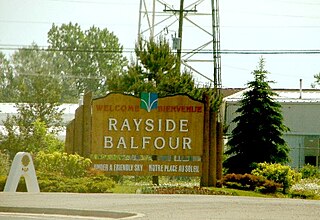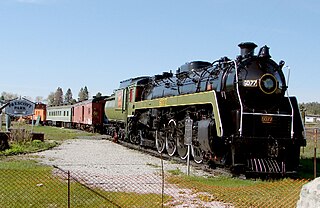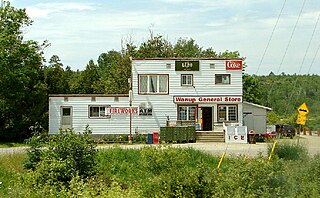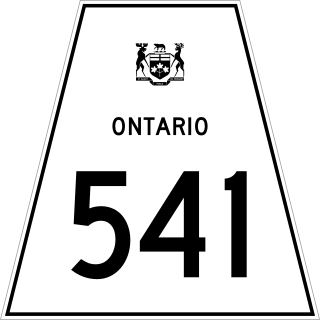
Sudbury, officially the City of Greater Sudbury, is the largest city in Northern Ontario by population, with a population of 166,004 at the 2021 Canadian Census. By land area, it is the largest in Ontario and the fifth largest in Canada. It is administratively a single-tier municipality and thus is not part of any district, county, or regional municipality. The City of Greater Sudbury is separate from, but entirely surrounded by the Sudbury District. The city is also referred to as "Grand Sudbury" among Francophones.
A regional municipality is a type of Canadian municipal government similar to and at the same municipal government level as a county, although the specific structure and servicing responsibilities may vary from place to place. Regional municipalities were formed in highly populated areas where it was considered more efficient to provide certain services, such as water, emergency services, and waste management over an area encompassing more than one local municipality. For this reason, regions may be involved in providing services to residents and businesses.

Nickel Centre was a town in Ontario, Canada, which existed from 1973 to 2000.

Rayside-Balfour was a town in Ontario, Canada, which existed from 1973 to 2000. It is now part of the city of Greater Sudbury.

Onaping Falls was a town in the Canadian province of Ontario, which existed from 1973 to 2000. It was created as part of the Regional Municipality of Sudbury, and took its name from the waterfalls on the Onaping River.

Capreol is a community in the Ontario city of Greater Sudbury. Situated on the Vermilion River, Capreol is the city's northernmost populated area.

Wanup is a dispersed rural community and unincorporated place in the geographic township of Dill in the southeast of the city of Greater Sudbury, Ontario, Canada. Wanup became part of Greater Sudbury on January 1, 2001, when that city was created by amalgamating the former Regional Municipality of Sudbury, to which the townships of Dill and Cleland were added.

Greater Sudbury City Council is the governing body of the City of Greater Sudbury, Ontario, Canada.
Peter Wong was a Canadian politician, who served as mayor of Sudbury, Ontario, from 1982 to 1991, and chair of the Regional Municipality of Sudbury from 1997 until his death the following year.
The Greater Sudbury municipal election, 2006 was held in the city of Greater Sudbury, Ontario, Canada on November 13, 2006. All municipal elections in the province of Ontario are held on the same date; see 2006 Ontario municipal elections for elections in other cities.
The Wahnapitae First Nation is an Ojibway First Nation band government in the Canadian province of Ontario, who primarily reside on the 1,036-hectare (2,560-acre) Wahnapitae Indian Reserve No. 11 on the northwestern shore of Lake Wanapitei. The First Nation is a signatory to the Robinson-Huron Treaty of 1850 as the Tahgaiwenene's Band. The reserve had a resident population of 102 in the Canada 2011 Census; the First Nation also has approximately 200 further registered members who currently live off-reserve.

Secondary Highway 537, commonly referred to as Highway 537, is a provincially maintained secondary highway in the Canadian province of Ontario. The highway is 16.1 kilometres (10.0 mi) in length, connecting Highway 69 near Wanup with Finni Road. It once continued 3.6 km (2.2 mi) further to intersect Highway 17 in Wahnapitae, but was truncated in 1998; this portion of the route is now designated as Greater Sudbury Municipal Road 537. Highway 537 is now the only secondary highway in the province located within a jurisdiction that also maintains its own county/regional road network.
A merger, consolidation or amalgamation, in a political or administrative sense, is the combination of two or more political or administrative entities, such as municipalities, counties, districts, etc., into a single entity. This term is used when the process occurs within a sovereign entity.
Frank Roger Mazzuca, Sr. was a Canadian politician and businessman in Capreol, Ontario. He served as mayor of the town from 1975 to 1997, and as chair of the Regional Municipality of Sudbury from 1998 to 2000.

Nickel Belt is a provincial electoral district located in the Canadian province of Ontario. It elects one member to the Legislative Assembly of Ontario. The district is located in Northern Ontario and includes much of the eastern and southern parts of the District of Sudbury, as well as most of Greater Sudbury outside the city's urban core. Communities include Lively, Onaping, Levack, Dowling, Chelmsford, Naughton, Azilda, Coniston, Wahnapitae, Garson, Val Caron, Val Thérèse, Hanmer and Capreol.
The 1997 Sudbury municipal election was held on November 10, 1997, as voters in Sudbury, Ontario and its outlying communities voted to elected mayors, councillors and school trustees. This was the last municipal election in the region prior to its amalgamation as the new city of Greater Sudbury.

Secondary Highway 541, commonly referred to as Highway 541, was a provincially maintained secondary highway in the Canadian province of Ontario. The highway connected Highway 17 in Sudbury with the community of Skead on the southern shores of Lake Wanapitei, passing through the community of Garson en route. Within the urban region of Sudbury, the highway served to access Sudbury Airport. The designation was applied in 1956, along with many of the secondary highways in Ontario. The province transferred responsibility for the route shortly after the creation of the Regional Municipality of Sudbury in 1973. Highway 541 is now known as Sudbury Municipal Road 86, following Falconbridge Highway and Skead Road.

Secondary Highway 545, commonly referred to as Highway 545, was a provincially maintained secondary highway in the Canadian province of Ontario. This 33.9-kilometre (21.1 mi) highway connected Highway 541 at Bailey Corners near Garson with the now-abandoned community of Milnet, passing through Hanmer and Capreol. It followed what is now Municipal Road 85, Municipal Road 84, and Milnet Road. The route featured a concurrency with Highway 69 between Hanmer and Capreol.
















